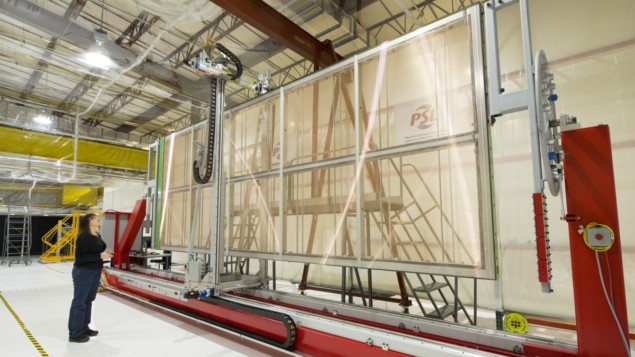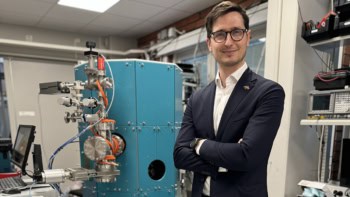
Neutrinos are detected by observing the particle showers they create when they strike nuclei, but new research using electrons in place of neutrinos shows that the models used to reconstruct the energy of the incoming neutrinos from these showers usually give wrong answers. Researchers say the work highlights well-known gaps in the theory of neutrino-nucleus interactions, and that improving this theory is crucial if next-generation neutrino detectors such as the Deep Underground Neutrino Experiment (DUNE) in the US and Hyper-Kamiokande in Japan are to realize their full potential.
The study of neutrino oscillations continues to provide tantalizing hints of physics beyond the Standard Model of particle physics. The Standard Model did not originally predict that neutrinos have mass, but both accelerator experiments and astronomical observations have clearly demonstrated that neutrinos can periodically change flavour between electron, muon and tau neutrinos as they propagate. This neutrino oscillation is possible only if neutrinos have mass, thus changing the Standard Model.
Characterizing neutrino oscillations is therefore one of the highest priorities in physics today. Or Hen of the Massachusetts Institute of Technology offers an example. “If there is large violation of charge-parity symmetry in how neutrinos and antineutrinos interact, then under certain assumptions that can explain why we live in a matter-dominated universe,” he says. “We really need to measure whether neutrinos and antineutrinos oscillate slightly differently.”
Energy reconstruction
Neutrinos’ oscillation rates depend on their energy, so one needs to know this to characterize neutrino oscillations and search for any possible anomalies. Unfortunately, neutrinos are notoriously difficult to detect because of their extremely weak interaction with matter. The details of individual experiments vary, but they invariably use an immense volume of matter (Hyper-Kamiokande will use water; DUNE will use liquid argon) surrounded by sensors. When a neutrino interacts with a nucleus in the matter, the sensors pick up ejected particles and reconstruct the energy of the incident neutrino.
One problem is that this requires knowledge of how neutrinos interact with the atomic nuclei. “Reconstructing the energy of a neutrino is like looking at fireworks in the sky and trying to work out the energy that ignited the explosion just by seeing all the beautiful colours,” explains Adi Ashkenazi of Tel Aviv University in Israel; “There are lots of free parameters in the simulation.”
Individual detectors are usually calibrated with beams of neutrinos. However, neutrinos are only produced by particle decay – which is inherently random – so producing a mono-energetic neutrino beam is impossible. This makes calibrating the incoming flux at a detector at each energy in the detection bandwidth unfeasible. Researchers at the e4ν (electrons for neutrinos) collaboration, however, used the simple and surprising alternative of studying how nuclei interact with electrons. Monoenergetic electron beams are simple to generate using particle accelerators, and Hen says that, although the fundamental physics of the electron-nucleus interaction is different from that of the neutrino-nucleus interaction, the real difficulties in the simulations arise from interactions between protons and neutrons in the nucleus, and these are identical in both cases.
Simple version of neutrinos
“In essence, electrons are a simple version of neutrinos, so whatever you think you know about neutrinos, if that same model cannot explain electron data, it’s wrong,” says Hen.
The e4ν researchers therefore teamed up with the CLAS Collaboration, based in Virginia (Hen and Ashkenazi are members of both groups), to study scattering data from 1999 in which electrons of known energies were scattered off either carbon, helium or iron targets. They selected a subset of these in which the scattering was relatively simple – producing only one detected electron and one proton. In a paper in Nature, the researchers analyse the electron interactions as though they were neutrinos, using standard simulations to reconstruct the energy of the incident particle. For carbon, only 30-40% of the simulations estimate the energy to be within 5% of the actual beam energy. For iron, the proportion is only 20-25%.

Sterile neutrinos ruled out by MicroBooNE, but mysterious excess remains unexplained
“You shouldn’t be surprised that the models don’t agree very well with the data,” says Eric Zimmerman of the University of Colorado Boulder; “There’s been a wide variety of neutrino interaction models produced and they’ve had quite a lot of variation in their predictions…I think this work’s principal value is that this dataset will presumably go into making the models better, if it hasn’t already.”
“To anyone who’s paying attention, this should be no surprise,” agrees Daniel Cherdack of the University of Houston in Texas; “The real question is who’s paying attention and why?” Both Zimmerman and Cherdack believe current results from detectors are trustworthy because model uncertainties have been factored into the error calculations. However, Cherdack says that these uncertainties will need to get smaller if larger detectors are to discover smaller effects. “This is an important paper in that it’s highlighting part of the ditch-digging of neutrino physics that doesn’t make it to the front very often, and the fact that Nature is focusing on this is incredibly important because this is one of the things we really need to figure out to make DUNE a successful experiment.”



